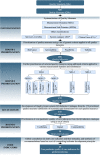Global core indicators for measuring WHO's paediatric quality-of-care standards in health facilities: development and expert consensus
- PMID: 35804384
- PMCID: PMC9270792
- DOI: 10.1186/s12913-022-08234-5
Global core indicators for measuring WHO's paediatric quality-of-care standards in health facilities: development and expert consensus
Abstract
Background: There are currently no global recommendations on a parsimonious and robust set of indicators that can be measured routinely or periodically to monitor quality of hospital care for children and young adolescents. We describe a systematic methodology used to prioritize and define a core set of such indicators and their metadata for progress tracking, accountability, learning and improvement, at facility, (sub) national, national, and global levels.
Methods: We used a deductive methodology which involved the use of the World Health Organization Standards for improving the quality-of-care for children and young adolescents in health facilities as the organizing framework for indicator development. The entire process involved 9 complementary steps which included: a rapid literature review of available evidence, the application of a peer-reviewed systematic algorithm for indicator systematization and prioritization, and multiple iterative expert consultations to establish consensus on the proposed indicators and their metadata.
Results: We derived a robust set of 25 core indicators and their metadata, representing all 8 World Health Organization quality standards, 40 quality statements and 520 quality measures. Most of these indicators are process-related (64%) and 20% are outcome/impact indicators. A large proportion (84%) of indicators were proposed for measurement at both outpatient and inpatient levels. By virtue of being a parsimonious set and given the stringent criteria for prioritizing indicators with "quality measurement" attributes, the recommended set is not evenly distributed across the 8 quality standards.
Conclusions: To support ongoing global and national initiatives around paediatric quality-of-care programming at country level, the recommended indicators can be adopted using a tiered approach that considers indicator measurability in the short-, medium-, and long-terms, within the context of the country's health information system readiness and maturity. However, there is a need for further research to assess the feasibility of implementing these indicators across contexts, and the need for their validation for global common reporting.
Keywords: Child health; Consultation; Global; Indicators; Measurement; Methodology; Quality-of-care; Robust; WHO quality-of-care standards; Young adolescent.
© 2022. The Author(s).
Conflict of interest statement
The authors declare no competing interests.
The authors declare that they have no competing interests.
Figures



References
-
- Kruk ME, Gage AD, Joseph NT, Danaei G, García-Saisó S, Salomon JA. Mortality due to low-quality health systems in the universal health coverage era: a systematic analysis of amenable deaths in 137 countries. The Lancet. 2018;392(10160):2203–2212. doi: 10.1016/S0140-6736(18)31668-4. - DOI - PMC - PubMed
-
- World Health Organization . Standards for improving quality of maternal and newborn care in health facilities. 2016.
Publication types
MeSH terms
Grants and funding
LinkOut - more resources
Full Text Sources

